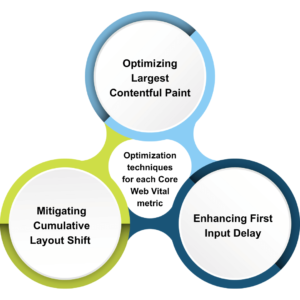Core Web Vitals, a set of user-centric metrics introduced by Google, have gained prominence as essential factors in determining website performance and user experience. For WooCommerce-powered online stores, optimizing Core Web Vitals can significantly impact conversion rates, search engine rankings, and customer satisfaction. In this blog post, we will explore effective strategies to optimize Core Web Vitals for WooCommerce, enhancing both website performance and user satisfaction.
Optimization techniques for each Core Web Vital metric:

Optimizing Largest Contentful Paint (LCP):
- Minimize server response time: Ensure your web hosting infrastructure is capable of handling WooCommerce’s demands and provides fast server response times.
- Optimize images: Compress images without compromising quality, use lazy loading techniques, and serve appropriate image sizes based on device viewport.
- Leverage caching: Implement caching mechanisms to store static resources and reduce the time it takes to fetch data.
- Prioritize critical resources: Load important elements first and defer non-essential JavaScript and CSS files.
Enhancing First Input Delay (FID):
- Minimize JavaScript execution time: Optimize JavaScript code, remove unused scripts, and use asynchronous loading for non-critical scripts.
- Reduce main thread work: Simplify complex CSS and minimize render-blocking resources to allow the browser to respond swiftly to user interactions.
- Utilize browser caching: Leverage browser caching to store pre-calculated values and speed up subsequent interactions.
Mitigating Cumulative Layout Shift (CLS):
- Set dimensions for media elements: Specify width and height attributes for images, videos, and iframes to avoid sudden layout shifts caused by content loading.
- Reserve space for ads: Leave placeholders with fixed dimensions for ad units to prevent sudden layout shifts when ads are loaded.
- Avoid dynamically injected content: Ensure that content added dynamically does not affect the layout of existing elements.
Optimizing Core Web Vitals for your WooCommerce website is vital for delivering an exceptional user experience, improving search engine rankings, and boosting conversion rates. By focusing on reducing Largest Contentful Paint (LCP), First Input Delay (FID), and Cumulative Layout Shift (CLS), you can enhance website performance, reduce bounce rates, and increase customer satisfaction. Implementing the optimization techniques discussed in this blog post will set you on the path to an optimized WooCommerce store that excels in Core Web Vitals and delivers a seamless shopping experience for your customers.
Optimize your website’s Core Web Vitals and boost its performance – contact us now!







